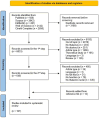Thalamus and consciousness: a systematic review on thalamic nuclei associated with consciousness
- PMID: 40642212
- PMCID: PMC12241866
- DOI: 10.3389/fneur.2025.1509668
Thalamus and consciousness: a systematic review on thalamic nuclei associated with consciousness
Abstract
Introduction: Consciousness relies on both cortical and subcortical structures and their feedforward and feedback pathways. Within this framework, the thalamus represents a relay station enabling the transmission, reception, and integration of information. However, it is divided into several nuclear groups each composed of functionally heterogeneous nuclei, and, to date, an agreement on which nuclei are most involved in the generation, maintenance, and modulation of consciousness is still lacking.
Methods: To fill this gap, we performed a systematic review by querying 5 electronic databases (MEDLINE/Pubmed, Scopus, EMBASE, Web of Science, and Cinahl Complete) about studies published in the last 20 years exploring the relationship between specific thalamic nuclei/nuclear groups and consciousness. For each included study, we extracted data supporting (i.e., positive evidence) or not (i.e., negative evidence) the relationship between a specific nucleus/nuclear group and the consciousness.
Results: 167 articles were included leading to 346 pieces of evidence of which 284 were positive. Most of the retrieved positive evidence pertained to the intralaminar nuclear group, followed by the mediodorsal and ventral nuclear groups. Furthermore, when considering the specific nuclei within the intralaminar nuclear group, results highlighted the centromedian-parafascicular complex (CM-Pf) as the nucleus most related to consciousness. Despite the high heterogeneity characterizing the adopted methodologies (e.g., brain stimulation, anesthesia, brain damage), as well as the study population (e.g., either healthy and pathological humans or animals) across studies, the greatest amount of evidence supported a key role of CM-Pf for the generation, modulation, and maintenance of the level of consciousness.
Discussion: Though there is more research on the role of intralaminar nuclei, there is proportionally more positive evidence supporting these nuclei (particularly the CM-Pf) as key nodes in the network underlying consciousness compared to other thalamic nuclei. These results support ongoing therapeutic approaches to disorders of consciousness by reinforcing the rationale behind brain stimulation targeting CM-Pf and paving the way for other potential candidates for targeted interventions.
Keywords: arousal; centromedian-parafascicular; consciousness; disorders of consciousness; neuromodulation; thalamus; wakefulness.
Copyright © 2025 Cacciatore, Magnani, Barbadoro, Ippoliti, Stanziano, Clementi, Nigri, Nanetti, Marino, La Porta, Lucca, Prada and Leonardi.
Conflict of interest statement
The authors declare that the research was conducted in the absence of any commercial or financial relationships that could be construed as a potential conflict of interest. The reviewer RA declared a shared affiliation with author FL to the handling editor at the time of the review.
Figures


Similar articles
-
Quality improvement strategies for diabetes care: Effects on outcomes for adults living with diabetes.Cochrane Database Syst Rev. 2023 May 31;5(5):CD014513. doi: 10.1002/14651858.CD014513. Cochrane Database Syst Rev. 2023. PMID: 37254718 Free PMC article.
-
Short-Term Memory Impairment.2024 Jun 8. In: StatPearls [Internet]. Treasure Island (FL): StatPearls Publishing; 2025 Jan–. 2024 Jun 8. In: StatPearls [Internet]. Treasure Island (FL): StatPearls Publishing; 2025 Jan–. PMID: 31424720 Free Books & Documents.
-
Measures implemented in the school setting to contain the COVID-19 pandemic.Cochrane Database Syst Rev. 2022 Jan 17;1(1):CD015029. doi: 10.1002/14651858.CD015029. Cochrane Database Syst Rev. 2022. Update in: Cochrane Database Syst Rev. 2024 May 2;5:CD015029. doi: 10.1002/14651858.CD015029.pub2. PMID: 35037252 Free PMC article. Updated.
-
Interventions for interpersonal communication about end of life care between health practitioners and affected people.Cochrane Database Syst Rev. 2022 Jul 8;7(7):CD013116. doi: 10.1002/14651858.CD013116.pub2. Cochrane Database Syst Rev. 2022. PMID: 35802350 Free PMC article.
-
Systemic pharmacological treatments for chronic plaque psoriasis: a network meta-analysis.Cochrane Database Syst Rev. 2021 Apr 19;4(4):CD011535. doi: 10.1002/14651858.CD011535.pub4. Cochrane Database Syst Rev. 2021. Update in: Cochrane Database Syst Rev. 2022 May 23;5:CD011535. doi: 10.1002/14651858.CD011535.pub5. PMID: 33871055 Free PMC article. Updated.
References
-
- Koch C. The quest for consciousness: a neurobiological approach. Englewood, Colorado: Roberts & Company Publishers. (2004).
-
- Arciniegas DB, Anderson CA, Filley CM. Behavioral neurology & neuropsychiatry. Cambridge, United Kingdom: Cambridge University Press; (2013).
Publication types
LinkOut - more resources
Full Text Sources
Miscellaneous

